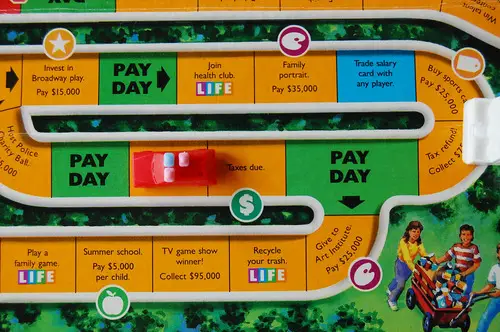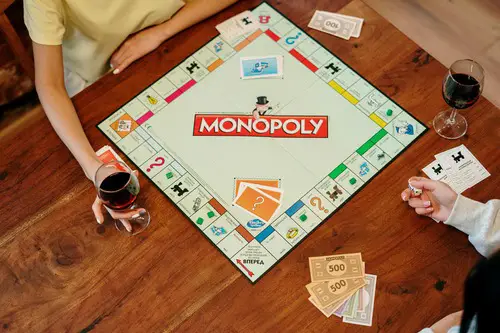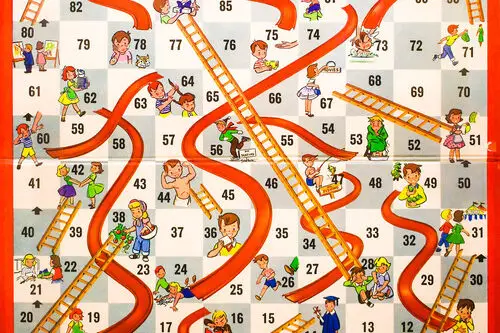1. The Game of Life Was Originally a Morality Lesson

When you spun that wheel in The Game of Life, it probably felt like a lighthearted ride through adult milestones. But the original version, created by Milton Bradley in 1860, was called The Checkered Game of Life, and it was more of a sermon than a game. Landing on spots like “Industry” or “Ruin” wasn’t just chance, it was meant to reflect the consequences of your choices. Instead of retirement in a mansion, the goal was to reach “Happy Old Age” through hard work and virtue.
It was basically a Victorian guide to how to behave and what society expected from you. Even the later versions kept that thread going, sneaking in ideas about debt, job titles, and success. It made adult life seem like a series of achievements you either hit—or missed. You might have just wanted to win with the most money, but the game was quietly lecturing you the whole time.
2. Monopoly Started as a Warning About Greed

Believe it or not, Monopoly wasn’t invented to glorify capitalism. It began in 1904 as The Landlord’s Game, created by Lizzie Magie to show how unchecked property ownership could hurt society. The original rules were actually meant to demonstrate the dangers of monopolies and the benefit of a more equal, shared system.
Of course, that message got flipped on its head when Parker Brothers turned it into the cutthroat game we all know. Instead of making players think critically about wealth inequality, it became a full-on celebration of bankrupting your friends. Every hotel and rent hike was supposed to sting—but it turned into bragging rights. The irony is almost too perfect.
3. Chutes and Ladders Was Once All About Karma

Chutes and Ladders feels harmless today, with its bright board and giggling tumbles down the slides. But its roots go back to ancient India, where it was known as Moksha Patam, a game meant to teach children moral lessons about virtue and vice. Ladders represented good deeds, while chutes (originally snakes) symbolized bad ones dragging you down.
It was a spiritual game designed to nudge kids toward a more virtuous life, not just a quick win. Every move was about cause and effect, and the game was supposed to mirror your journey toward enlightenment—or failure. Somewhere along the line, that message got replaced with silly cartoon illustrations and candy-colored designs. But its original intent was far deeper than it looks now.
4. Musical Chairs Was Designed to Reflect Scarcity

You probably just remember the frantic scramble and the panic when the music stopped. But Musical Chairs is essentially a child’s introduction to the idea of scarcity and competition. There’s always one fewer chair than players, so someone has to lose, no matter how fast or fair they play.
It’s a tough concept to swallow when you’re five, but that feeling of being left out was the point. The game forces kids to act quickly and aggressively just to keep a seat at the table, literally. It mirrors what adult life can feel like—fighting for limited spots, resources, or recognition. It’s fun in theory, but kind of brutal when you think about the message underneath.
5. Duck, Duck, Goose Teaches the Danger of Being Targeted

At first glance, Duck, Duck, Goose just looks like an innocent circle of kids yelling and running. But the core of the game is about isolation and pursuit. One child is marked and has to break from the crowd, fleeing for safety while someone chases them down.
It unintentionally mirrors real-life situations where someone is singled out, whether socially or competitively. There’s something very primal about that chase, and the tension it builds. Even though it’s wrapped in playground giggles, it plants a subtle seed about being chosen—or left out—for reasons beyond your control. It’s fun, but it’s also a lesson in social hierarchy and instinct.
6. Red Rover Was All About Strength and Exclusion

Red Rover seems simple—call someone over, try to break the chain. But underneath the bruises and scraped knees, it’s a physical test of who’s strong enough to break in—and who’s left out. If you couldn’t break the chain, you joined it. If you could, you chose who to take back with you. Either way, it was a game about power.
It might’ve looked like fun teamwork, but it really highlighted who was stronger, faster, or more favored. Some schools even banned it for being too aggressive, which says a lot. It mimicked adult dynamics more than we realized, with alliances, force, and exclusion all baked into a few rounds of shouting and running.
7. Simon Says Was a Test in Obedience

“Simon says, touch your nose.” You probably followed without thinking. But Simon Says is actually a masterclass in learning obedience and the consequences of missteps. The whole goal is to trip you up if you stop listening or act without the right command.
It’s less about fun and more about paying attention, following directions, and responding to authority. The leader has total control, and everyone else has to fall in line or be eliminated. It’s a perfect example of how play was often used to prepare kids for strict systems—like school or even military-style discipline. All under the guise of a silly game.
